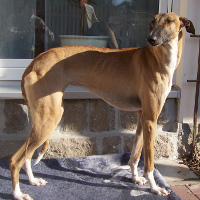Appearance of the Chortai
|
| The Chortai has a lean but muscular body, long slender legs and a narrow wedge-shaped head supported by a long muscular neck. While the dog looks skinny, it is surprisingly robust, with immense strength and stamina that enable it to run around all day. Bred to be a working dog, they have adapted magnificently to the often harsh climate and have been known to do up to 10 chases a day to provide food for their master. Unsurprisingly, these hard-working dogs have deep chests, broad backs and well-defined withers. They have a folded abdomen and a long, saber-shaped tail that often has a curl at the end. Their body is elegant and their face perfectly chiseled, with a long, pointed muzzle, black or brown nose and large, almond-shaped eyes often surrounded by a black rim. The Chortai has short, thin ears in line with its eyes. They come in a variety of colors and have short, dense coats to keep them warm in the winter months. Chortai are beautiful to watch as they whirl around, with a grace and fluidity that seems effortless and truly graceful. |
Temperament of the Chortai
|
| Chortai have spent years adapting to their working lives, with breeding focusing on their purpose rather than their appearance, but they are elegant, handsome dogs. They are known for their kindness and loyalty to their master and family, and aggression is not a common trait. Bred to work alone or in packs, these dogs enjoy the company of other dogs and get on well with domestic animals and livestock. However, they are hunting dogs with a strong instinct to take off after small, fast-moving animals, as is their nature, so caution is advised with small pets and they should be kept on a leash when out walking. They can be aloof and have an independent nature derived from their ability to hunt on their own and bring back what they've caught. Intelligent but obedient, they need to be socialized early in life to be fully integrated into family life. They are affectionate and loyal, but because of their friendliness, they do not make good guard dogs. The Chortai excels in competitions and races and possesses excellent agility, so they could excel in a variety of disciplines. This dog has existed for eons on scraps and small meals of bread and oats, so its diet should be minimal, check with your vet what is the best food for this dog. High-protein diets are known to cause intolerance within the breed, and bloat can be a problem if you feed them too much. Bloat can be a potentially fatal condition without veterinary intervention. A young dog will need a specialized diet to enable it to develop to its full potential. The Chortai is a rare breed of dog, most of which still lives in its place of origin, still hunting prey to feed its master. |
Needs and activities of the Chortai
|
| The Chortai is an extremely active dog, bred to hunt and run all day, so it has specific exercise requirements. This dog is an ideal companion for a marathon runner, competitive jogger or cyclist. Wide open spaces are best for the Chortai dog, although some have adapted to life in the city. You must remember that they have a finely-honed hunting instinct that cannot be trained out of them. Therefore, a leash is vital for this dog. Gentle with children and family members, he also gets on well with other dogs and enjoys ball games, especially retrieving. Throw the ball as far as you can and they'll retrieve it. They'll play for hours, are resilient, energetic and very athletic. This dog is no couch potato and, like many dogs, needs to expend its energy. The moment you confine a dog like this for a while, that energy has to go somewhere and that's when you get behavioral problems such as chewing everything in sight, digging and sometimes being aggressive. Chortai will need two long hard walks every day to maintain their health. They respond well to training and activities such as obstacle course training, and other physical sports are an excellent outlet for their abundant energy. Of course, they're a perfect hunting companion, and for larger game, they'll follow and hold off until you come to dispatch the game. |
Maintenance of the Chortai
|
| Chortai are very easy to care for, as they have a short but dense coat that only requires weekly brushing. They rarely need a bath as they keep themselves very clean, but rubbing with a soft, damp cloth will remove dust or dirt from the coat. A bath will be necessary if the dog has been through mud, but use a gentle dog shampoo to preserve the natural oils in his coat that protect him from the elements. A hunting dog may need to bathe more often after being exposed to the elements, pet dogs won't need it as often. While your Chortai is still a puppy, get him used to having his ears cleaned, his nails trimmed and teach him to have his teeth brushed. It's so much easier to train a puppy than to change the habits of an older dog. This is a very robust breed of dog, and they've been used to taking care of themselves, so maintenance is very low. |







 English (United Kingdom)
English (United Kingdom)